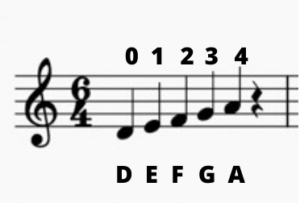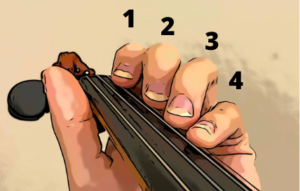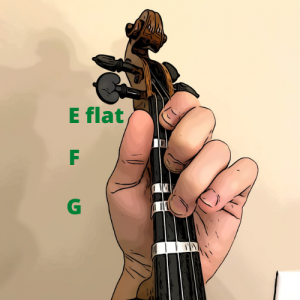Violin D string notes and fingering: Notes and tips
The main notes while playing violin on the D string are open D, E, F, G, and A. These are natural or diatonic notes which you can alter with sharps or flats depending on the key and accidentals.


- The first note on the D string is open D. Each successive finger after the first finger( index finger) that you place on the fingerboard will produce the next successive note. Remember that the number assigned to each finger is not the same as on a piano keyboard, and it starts with the index finger as the first finger, middle as the second, etc.
- When you see sharps or flats before any notes or in a key, you have to play them with the same finger by putting or sliding it higher or lower than the original note. Pay attention to the distance between half and whole steps. When playing half steps, place the fingers close to each other, with no space between them.
- Maintain the correct posture and angle of the left hand and fingers. Keep the fingers over or above the string. Don’t hide them under the fingerboard or away from the string. Keep the left hand free and relaxed. The wrist should stay straight and not be bent inward or outward, preventing your left hand from getting tense. If you feel tension in your left hand or fingers, it is time to stop playing and analyze what you can do to improve your left hand technique. This can include adjusting your left-hand angle, posture, or the rotation of the wrist when playing with the fourth finger.
When you have an ascending melodic line, keep preceding fingers on the fingerboard. For example, if you play E note ( 1st finger), F note (2nd finger), and are going to play G note ( 3rd finger), keep your first and second fingers on the string, in their E and F note positions.

Violin D string notes finger placement. Play without tension and keep your hand free and relaxed
How to keep the left hand free and relaxed. when playing on the D string. Physical aspects and suggestions for tension-free playing on the D string.
- Place the fingers directly over the string where you should be able to drop and lift them from their base joints. It’s incorrect to hide the fingers under the fingerboard or keep them away from the string. Don’t make this a habit!
- Don’t clench the neck with the thumb and the first finger. The thumb should hover over the side of the neck freely. The violin’s neck can rest on the base joint of the first finger.
- Keep your fingers rounded and relaxed. Apply only a sufficient amount of pressure to push the string closer to the fingerboard so that it slightly touches it. There is no need to apply a lot of pressure!
- The forearm should be almost vertical or brought a little bit inward depending on the violin placement and the tilt of the instrument. You want to place the fingers on the D string at the same angle as when you play on the G string or other strings. For this, in order to keep your fingers on the strings, the left-hand elbow should move slightly inward for each successive lower string. Conversely, the left-hand elbow will move slightly outward for each successive higher string.
- When playing with the fourth finger, consider moving its base knuckle closer to the neck in order to reduce stretching and unnecessary tension. Keep the wrist straight and rotate it clockwise so it stays parallel to the edge of the fingerboard. Exercises for the left hand such as Sevcik or Shradieck will help to strengthen your fingers. You can download them here.
- Don’t force the left hand to the point of physical strain or discomfort. If you feel that it’s not flexible enough, then warm it up a little bit by doing stretching or finger exercises. It is recommended to establish an everyday warm-up routine before playing the violin. If you feel tired, take a break. Strain and tension can lead to micro-injuries which are not uncommon among musicians.
More about:
Violin fingering- G string pinkie placement- read here
Violin E string notes- read here
How to hold a violin bow for beginners- read here
Vibrato on violin: How to do it effortlessly
I would love to answer any questions related to violin lessons and violin playing. You can email me at [email protected] or book your free trial lesson here.
